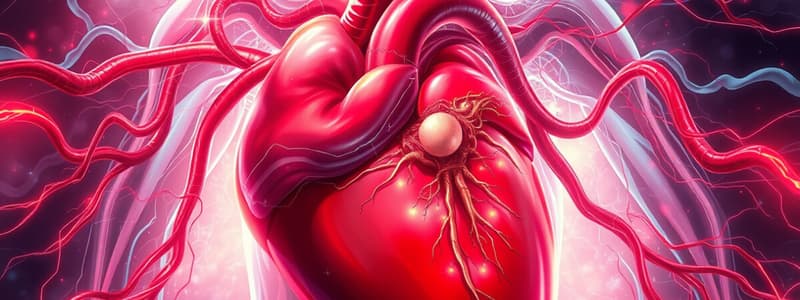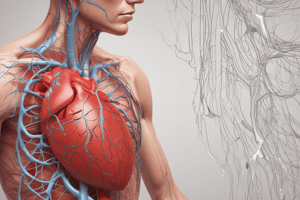Podcast
Questions and Answers
What is primarily responsible for controlling blood flow to different tissues in the body?
What is primarily responsible for controlling blood flow to different tissues in the body?
- Cardiac output and peripheral resistance (correct)
- The oxygenation level of the blood
- The arrangement of blood vessels
- The viscosity of the blood
How does the arrangement of blood vessels within each circulation benefit organ function?
How does the arrangement of blood vessels within each circulation benefit organ function?
- It ensures uniform blood pressure across all organs.
- It allows for independently regulated blood flow to each organ. (correct)
- It restricts blood flow based on body temperature.
- It minimizes blood flow to less active regions.
Why is it important to control both cardiac output and peripheral resistance?
Why is it important to control both cardiac output and peripheral resistance?
- To ensure adequate flow to tissues based on their immediate needs. (correct)
- To optimize the heart's pumping rate only.
- To prevent blood from pooling in one area.
- To maintain a constant blood volume regardless of activity.
What does the percentage distribution of cardiac output suggest about organ performance?
What does the percentage distribution of cardiac output suggest about organ performance?
What characteristic of the cardiovascular system aids in adapting blood flow to different organs?
What characteristic of the cardiovascular system aids in adapting blood flow to different organs?
What is the primary function of the circulatory system's parts?
What is the primary function of the circulatory system's parts?
What is meant by 'transmural blood pressure'?
What is meant by 'transmural blood pressure'?
Which mathematical expression is used to calculate mean arterial pressure (MAP)?
Which mathematical expression is used to calculate mean arterial pressure (MAP)?
What contributes to variations in pulse pressure across the circulatory system?
What contributes to variations in pulse pressure across the circulatory system?
How does the law of LaPlace relate to heart failure?
How does the law of LaPlace relate to heart failure?
What physiological basis explains the volume of distribution of blood in the body?
What physiological basis explains the volume of distribution of blood in the body?
What is defined as 'driving pressure' in the context of hemodynamics?
What is defined as 'driving pressure' in the context of hemodynamics?
Which of the following factors does NOT determine pulse pressure?
Which of the following factors does NOT determine pulse pressure?
What effect does age have on vascular compliance?
What effect does age have on vascular compliance?
What is the relationship between stiffness (or elastance) and compliance?
What is the relationship between stiffness (or elastance) and compliance?
What is the effect of vasoconstriction on vascular compliance?
What is the effect of vasoconstriction on vascular compliance?
What does 'dynamic compliance' refer to?
What does 'dynamic compliance' refer to?
Which of the following factors can specifically lead to decreased compliance?
Which of the following factors can specifically lead to decreased compliance?
What is pulse pressure?
What is pulse pressure?
Which factor does NOT influence pulse pressure?
Which factor does NOT influence pulse pressure?
How is mean arterial pressure best calculated assuming a normal heart rate?
How is mean arterial pressure best calculated assuming a normal heart rate?
Which statement about driving pressure is accurate?
Which statement about driving pressure is accurate?
In which region of the circulatory system would you typically find the largest pulse pressure?
In which region of the circulatory system would you typically find the largest pulse pressure?
How do the structures of arteries primarily contribute to their function as elastic vessels?
How do the structures of arteries primarily contribute to their function as elastic vessels?
What characterizes a pulsus paradoxus pulse pattern?
What characterizes a pulsus paradoxus pulse pattern?
What is the primary effect of changes in cardiac output on the arterial system?
What is the primary effect of changes in cardiac output on the arterial system?
Which of the following describes a hyperkinetic pulse?
Which of the following describes a hyperkinetic pulse?
How do veins primarily facilitate blood return to the heart?
How do veins primarily facilitate blood return to the heart?
What physiological basis explains the volume distribution of blood in the body?
What physiological basis explains the volume distribution of blood in the body?
What effects does peripheral resistance have on blood circulation?
What effects does peripheral resistance have on blood circulation?
Which of the following pulse types indicates significant cardiovascular instability?
Which of the following pulse types indicates significant cardiovascular instability?
Flashcards are hidden until you start studying
Study Notes
Hemodynamics Overview
- The circulatory system consists of two linked circulations: systemic and pulmonary.
- Each circulation receives and ejects an equal volume of blood per minute, a balance maintained by the Frank-Starling mechanism.
Blood Distribution and Physiological Basis
- Blood is distributed throughout the body, with specific volumes allocated to different organ systems during rest. Each tissue's blood flow is precisely controlled.
- Cardiac output regulates volume and pressure in circulation, while peripheral resistance ensures tissues receive adequate flow.
Pulse Pressure
- Systolic Pressure (SP): Maximum arterial pressure during left ventricular contraction.
- Diastolic Pressure (DP): Minimum arterial pressure at the end of heart relaxation.
- Pulse Pressure (PP): The difference between systolic and diastolic pressures (PP = SP - DP).
- Influenced by arterial compliance—high compliance leads to lower PP, while low compliance (due to stiffness or vasoconstriction) increases PP.
Mean Arterial Pressure (MAP)
- Represents the average arterial pressure during a single cardiac cycle.
- Calculated using the formula involving blood pressure readings and heart rate; influences and varies across ventricles and circulations.
Driving Pressure
- Defined as the pressure gradient that drives blood flow through the circulatory system.
- Pathological alterations in driving pressure may contribute to heart failure.
Arterial and Venous Structures
- Arteries are elastic vessels, providing stability and ability to withstand high pressures; veins are compliant, accommodating varying blood volumes.
Forms of Pulse Pressure
- Pulsus Paradoxus: Significant drop in systolic pressure during inspiration.
- Pulsus Parvus and Tardus: Weak, delayed pulse often associated with aortic stenosis.
- Hyperkinetic Pulse: Strong, bounding pulse indicating high cardiac output.
- Dicrotic Pulse: Characterized by a secondary, small rise in the pressure wave indicating aortic valve closure.
- Pulsus Alternans: Alternating strong and weak pulses indicative of poor ventricular function.
Compensation Mechanisms
- Changes in cardiac output or peripheral resistance activate compensatory mechanisms to normalize blood flow through arteries, ensuring adequate tissue perfusion.
Studying That Suits You
Use AI to generate personalized quizzes and flashcards to suit your learning preferences.





